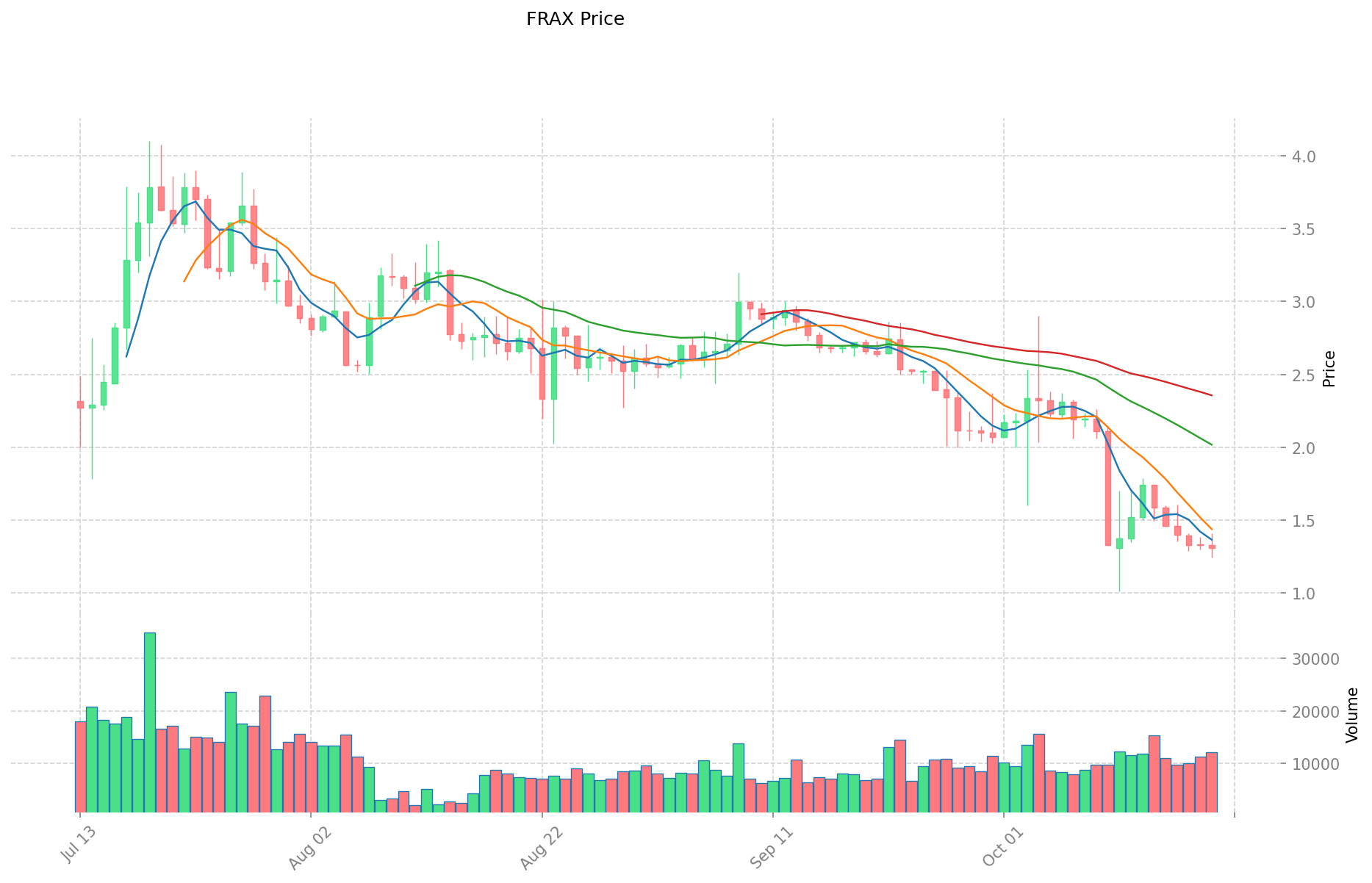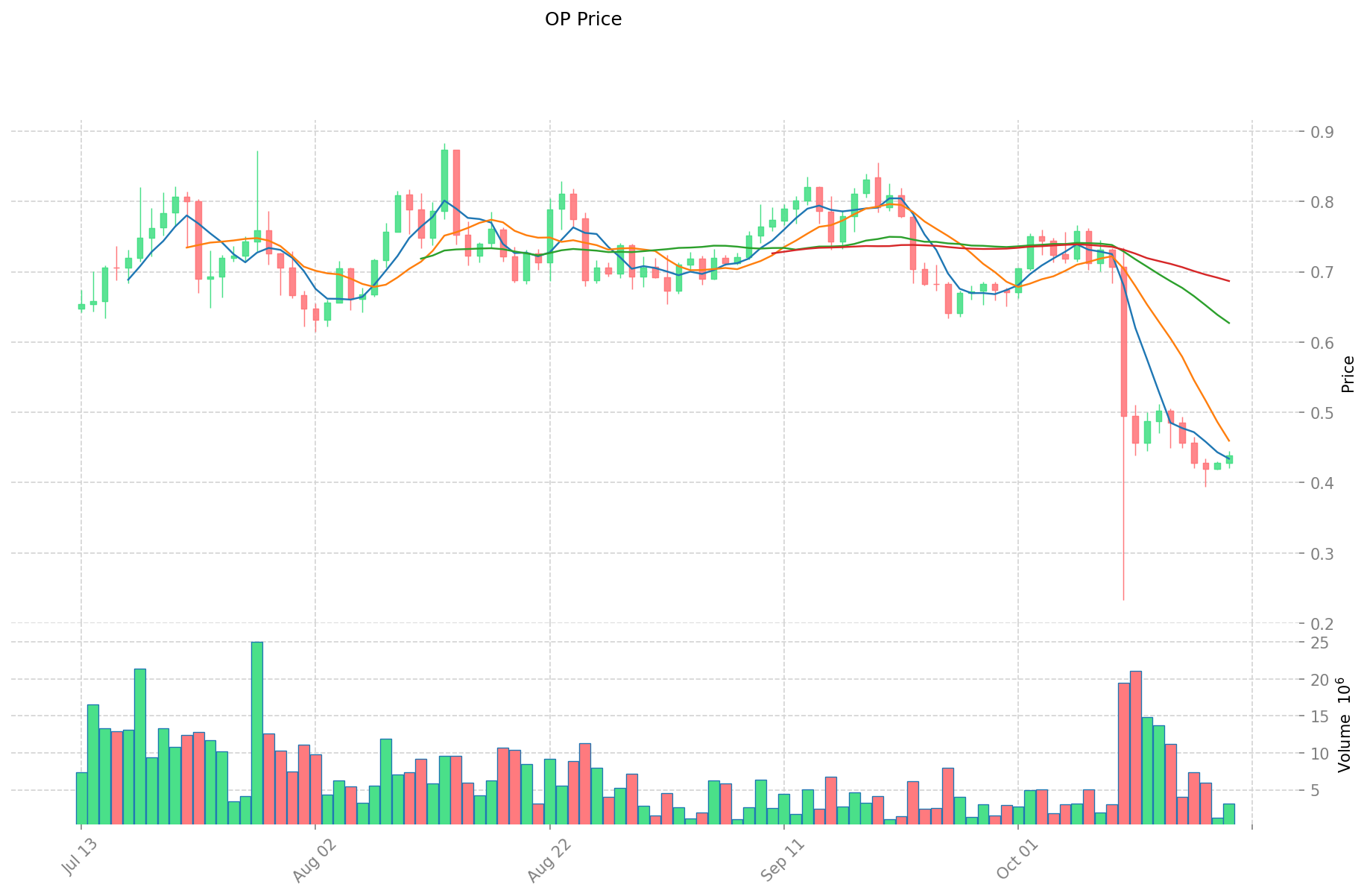FRAX ve OP: Ethereum ekosistemindeki iki yenilikçi DeFi protokolünü karşılaştırıyoruz


Giriş: FRAX ve OP Yatırımı Karşılaştırması
Kripto para piyasasında FRAX ve OP karşılaştırması, yatırımcıların göz ardı edemeyeceği bir başlık olarak öne çıkıyor. Her iki varlık; piyasa değeri sıralaması, kullanım alanları ve fiyat performansı açısından belirgin farklılıklar sergilerken, kripto varlık ekosisteminde de farklı pozisyonlar üstleniyor.
FRAX (FRAX): Lansmanından bu yana, “fraktal ölçeklenme” yol haritasına sahip modüler rollup blokzinciri olarak, piyasada önemli bir kabul görmüştür.
OP (OP): Düşük maliyetli ve yüksek hızda işlem sunan bir Ethereum Layer 2 blokzinciri olarak tanıtılan OP, küresel çapta en fazla işlem gören ve en yüksek piyasa değerine sahip kripto paralar arasında yer almıştır.
Bu makale; FRAX ve OP'nin yatırım değerini, geçmiş fiyat eğilimleri, arz mekanizmaları, kurumsal benimseme, teknolojik ekosistem ve gelecek öngörüleri temelinde kapsamlı biçimde analiz ederek, yatırımcıların en çok merak ettiği şu soruya yanıt arıyor:
"Şu anda hangisi daha avantajlı bir yatırım?"
I. Fiyat Geçmişi Karşılaştırması ve Güncel Piyasa Durumu
FRAX ve OP Tarihsel Fiyat Eğilimleri
- 2023: FRAX, stablecoin olma özelliğiyle fiyat istikrarını koruyarak $1 seviyesine yakın hareket etti.
- 2024: OP, anlamlı bir değer artışı yaşadı ve 6 Mart 2024’te tüm zamanların en yüksek seviyesi olan $4,84'e ulaştı.
- Karşılaştırmalı analiz: Son piyasa döngüsünde FRAX stablecoin olarak görece istikrarlı kalırken, OP tüm zamanların zirvesinden $0,34081 seviyesine kadar sert dalgalanmalar gösterdi.
Güncel Piyasa Durumu (20 Ekim 2025)
- FRAX güncel fiyatı: $1,31
- OP güncel fiyatı: $0,4385
- 24 saatlik işlem hacmi: FRAX $16.173,22; OP $1.390.068,50
- Piyasa Duyarlılık Endeksi (Korku & Açgözlülük Endeksi): 29 (Korku)
Gerçek zamanlı fiyatları görmek için tıklayın:
- FRAX güncel fiyatını görüntüle Piyasa Fiyatı
- OP güncel fiyatını görüntüle Piyasa Fiyatı


II. FRAX ve OP Yatırım Değerini Etkileyen Temel Unsurlar
Arz Mekanizması Karşılaştırması (Tokenomik)
-
FRAX: Kısmen teminatlı algoritmik stablecoin modeli; fraksiyonel rezerv ve algoritmik yapı bir arada bulunur
-
OP: Enflasyonist model; kademeli token dağıtımı ve Ethereum kullanıcılarına/ilk dönem kullanıcılara yapılan airdrop'lar içerir
-
📌 Tarihsel görünüm: FRAX, stablecoin tasarımı sayesinde görece istikrarlı kalırken; OP, dağıtım etkinlikleri ve ekosistem büyümesiyle daha dalgalı fiyat hareketleri yaşar.
Kurumsal Benimseme ve Piyasa Uygulamaları
- Kurumsal varlıklar: OP, Optimism Collective ve a16z gibi büyük destekçiler sayesinde daha fazla kurumsal ilgiyle karşılaşırken; FRAX, DeFi odaklı kurumsal katılımı çekmektedir
- Kurumsal kullanım: FRAX, hazine yönetimi ve DeFi altyapısında istikrar sunarken; OP, Ethereum ölçeklenme çözümleri ile Layer-2 altyapı uygulamalarına odaklanır
- Düzenleyici durum: Stablecoin’ler (FRAX) dünya genelinde giderek artan regülasyon baskısı altındadır; OP ise bir Layer-2 altyapı tokenı olarak daha az doğrudan regülasyon etkisiyle karşılaşır
Teknik Gelişim ve Ekosistem İnşası
- FRAX teknik güncellemeleri: FraxFerry köprüsü, frxETH likit staking, çeşitli DeFi protokollerine entegrasyon
- OP teknik gelişimi: OP Stack, Bedrock yükseltmesiyle işlem kapasitesinin artması ve işlem ücretlerinin düşmesi, genişleyen Superchain vizyonu
- Ekosistem karşılaştırması: FRAX DeFi protokollerinde güçlü entegrasyon ve getiri üretimi sağlarken; OP, düşük işlem maliyetiyle Ethereum ölçeklenmesini kullanan büyüyen dApp ekosistemine güç verir
Makroekonomik ve Piyasa Döngüleri
- Enflasyon performansı: FRAX, farklı ekonomik koşullarda istikrar sunmak için tasarlanmıştır; OP ise genel kripto piyasa döngüleriyle daha yakından ilişkilidir
- Para politikası etkisi: Faiz değişimleri FRAX'ın istikrar mekanizması ve getiri fırsatlarını etkilerken; OP genel kripto piyasa duyarlılığından daha çok etkilenir
- Jeopolitik faktörler: FRAX, kısıtlayıcı bölgelerde USD alternatifi olarak kullanılabilir; OP ise ölçeklenebilir blokzincir altyapısına olan talep artışından faydalanır
III. 2025-2030 Fiyat Tahmini: FRAX ve OP
Kısa Vadeli Tahmin (2025)
- FRAX: Muhafazakâr $0,85215 - $1,311 | İyimser $1,311 - $1,56009
- OP: Muhafazakâr $0,33136 - $0,436 | İyimser $0,436 - $0,53628
Orta Vadeli Tahmin (2027)
- FRAX büyüme fazına geçebilir, fiyat aralığı $1,209303108 - $1,984497408
- OP büyüme fazına geçebilir, fiyat aralığı $0,458746011 - $0,702277844
- Temel itici faktörler: Kurumsal sermaye girişi, ETF'ler, ekosistem gelişimi
Uzun Vadeli Tahmin (2030)
- FRAX: Temel senaryo $1,41087021515802 - $2,3514503585967 | İyimser senaryo $2,3514503585967 - $2,633624401628304
- OP: Temel senaryo $0,423865614856068 - $0,6728025632636 | İyimser senaryo $0,6728025632636 - $0,77372294775314
Feragatname
FRAX:
| Yıl | Tahmini En Yüksek Fiyat | Tahmini Ortalama Fiyat | Tahmini En Düşük Fiyat | Fiyat Değişimi (%) |
|---|---|---|---|---|
| 2025 | 1,56009 | 1,311 | 0,85215 | 0 |
| 2026 | 1,6652322 | 1,435545 | 1,36376775 | 9 |
| 2027 | 1,984497408 | 1,5503886 | 1,209303108 | 18 |
| 2028 | 2,10325717476 | 1,767443004 | 1,62604756368 | 35 |
| 2029 | 2,7675506278134 | 1,93535008938 | 1,354745062566 | 47 |
| 2030 | 2,633624401628304 | 2,3514503585967 | 1,41087021515802 | 79 |
OP:
| Yıl | Tahmini En Yüksek Fiyat | Tahmini Ortalama Fiyat | Tahmini En Düşük Fiyat | Fiyat Değişimi (%) |
|---|---|---|---|---|
| 2025 | 0,53628 | 0,436 | 0,33136 | 0 |
| 2026 | 0,6465662 | 0,48614 | 0,3305752 | 11 |
| 2027 | 0,702277844 | 0,5663531 | 0,458746011 | 29 |
| 2028 | 0,69140386448 | 0,634315472 | 0,58357023424 | 44 |
| 2029 | 0,6827454582872 | 0,66285966824 | 0,563430718004 | 51 |
| 2030 | 0,77372294775314 | 0,6728025632636 | 0,423865614856068 | 53 |
IV. Yatırım Stratejisi Karşılaştırması: FRAX ve OP
Uzun Vadeli ve Kısa Vadeli Yatırım Stratejileri
- FRAX: İstikrar ve DeFi altyapısına odaklanan yatırımcılar için uygun
- OP: Ethereum ölçeklenme çözümleri ve ekosistem büyümesine odaklanan yatırımcılar için uygun
Risk Yönetimi ve Varlık Dağılımı
- Muhafazakâr yatırımcılar: FRAX %70 - OP %30
- Agresif yatırımcılar: FRAX %40 - OP %60
- Koruma araçları: Stablecoin dağılımı, opsiyonlar, çoklu para portföyleri
V. Potansiyel Risk Karşılaştırması
Piyasa Riski
- FRAX: Sabit fiyat riskleri, teminat oynaklığı
- OP: Kripto piyasa duyarlılığına yüksek bağlılık
Teknik Risk
- FRAX: Algoritmik istikrar, akıllı kontrat açıkları
- OP: Ölçeklenme sorunları, yoğun kullanımda ağ tıkanıklığı
Düzenleyici Risk
- Küresel regülasyon politikaları stablecoin’ler (FRAX) ve layer-2 çözümler (OP) üzerinde farklı etkiler yaratır
VI. Sonuç: Hangisi Daha Avantajlı Alım?
📌 Yatırım Değeri Özeti:
- FRAX avantajları: İstikrar, DeFi entegrasyonu, USD alternatifi olma potansiyeli
- OP avantajları: Ethereum ölçeklenme çözümü, gelişen ekosistem, kurumsal destek
✅ Yatırım Tavsiyesi:
- Yeni yatırımcılar: İstikrar için FRAX'a daha yüksek oran ayırarak dengeli bir portföy oluşturmayı düşünün
- Tecrübeli yatırımcılar: FRAX ile korunma sağlarken OP ekosistemindeki fırsatları değerlendirin
- Kurumsal yatırımcılar: Uzun vadeli altyapı yatırımı için OP'yi değerlendirin, hazine yönetiminde FRAX'ı kullanın
⚠️ Risk Uyarısı: Kripto para piyasası aşırı dalgalıdır. Bu makale yatırım tavsiyesi değildir. None
VII. Sıkça Sorulan Sorular
S1: FRAX ve OP arasındaki temel farklar nelerdir? C: FRAX, fiyat istikrarı için tasarlanmış kısmen teminatlı algoritmik bir stablecoin iken; OP, fiyatı daha değişken olan bir Ethereum Layer 2 ölçeklenme çözümü tokenıdır. FRAX, $1 seviyesine yakın değer korumaya odaklanırken OP'nin fiyatı benimseme ve piyasa koşullarına göre dalgalanır.
S2: Son dönemde hangi token daha iyi fiyat performansı gösterdi? C: OP, Mart 2024’te $4,84 ile tarihi zirvesine ulaşarak daha yüksek fiyat artışı yaşadı. FRAX ise stablecoin olması nedeniyle $1 civarında istikrarını korudu; 20 Ekim 2025 itibarıyla güncel fiyatı $1,31’dir.
S3: FRAX ve OP'nin arz mekanizmaları nasıl farklılık gösteriyor? C: FRAX, fraksiyonel rezervli kısmen teminatlı algoritmik model kullanırken; OP, airdrop'ları da içeren enflasyonist bir modelle kademeli token dağıtımı gerçekleştiriyor.
S4: FRAX ve OP'nin yatırım değerini etkileyen başlıca faktörler nelerdir? C: Arz mekanizması, kurumsal benimseme, teknik gelişim, ekosistem inşası ve makroekonomik koşullar temel faktörlerdir. FRAX istikrar ve DeFi entegrasyonundan; OP ise Ethereum ölçeklenme ve ekosistem büyümesinden etkilenir.
S5: FRAX ve OP'nin uzun vadeli fiyat tahminleri nasıl karşılaştırılır? C: 2030'a kadar FRAX'ın $1,41 ile $2,63 arasında; OP'nin ise $0,42 ile $0,77 aralığında olacağı öngörülüyor. Bu tahminler, her iki token için büyüme potansiyeline işaret ederken, FRAX stablecoin olarak daha yüksek nominal değeri koruyacaktır.
S6: FRAX ve OP yatırımlarında başlıca riskler nelerdir? C: FRAX için temel riskler arasında sabit fiyat riskleri, teminat oynaklığı ve stablecoin’lere yönelik regülasyon incelemesi yer alıyor. OP için ise piyasa duyarlılığına bağlılık, ölçeklenme sorunları ve ağ tıkanıklığı öne çıkıyor.
S7: Farklı yatırımcı profilleri FRAX ve OP’ye nasıl yaklaşmalı? C: Muhafazakâr yatırımcılar istikrar için FRAX’a daha fazla oran ayırabilir. Tecrübeli yatırımcılar, FRAX ile korunurken OP ekosisteminde fırsat arayabilir. Kurumsal yatırımcılar, altyapı yatırımı için OP’yi değerlendirip hazine için FRAX kullanabilir.

2025 OBOL Fiyat Tahmini: Yükselen Kripto Para Birimine Yönelik Potansiyel Büyüme ve Piyasa Faktörlerinin Analizi

2025 POL Fiyat Tahmini: Polygon’un Yerel Token’ı İçin Potansiyel Büyüme Dinamikleri ve Piyasa Eğilimlerinin Analizi

2025 OP Fiyat Tahmini: Optimism’in Layer 2 (Katman 2) Ölçekleme Çözümlerindeki Uzun Vadeli Değer Potansiyelinin Analizi

2025 LINEA Fiyat Tahmini: Layer 2 Çözümüne Yönelik Piyasa Trendleri, Teknik Gelişmeler ve Benimsenme Unsurlarının Analizi

Starknet (STRK) yatırım için uygun mu?: Ethereum'a yönelik bu Layer 2 ölçeklendirme çözümünün potansiyelini inceliyoruz

LightLink (LL) iyi bir yatırım mı?: Bu yükselen blockchain platformunun DeFi ekosistemindeki potansiyelini analiz ediyoruz

NFT’lerin Kavramını ve Tanımını Anlamak

AURASOL nedir: Gelişmiş cilt bakım teknolojisi ve devrim niteliğindeki faydalarına dair kapsamlı bir rehber

ELA nedir: İngilizce Dil Sanatları Eğitimi ve Öğrenci Gelişimindeki Önemi Hakkında Kapsamlı Bir Rehber

Önde Gelen Bir Blockchain Platformunun Avantajları ve Özelliklerini Keşfedin

StarkNet'i Keşfetmek: StarkEx ile Ethereum Ölçeklendirmesinde Uzmanlaşmak







